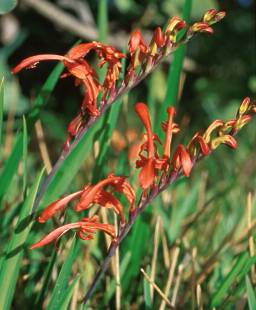Chasmanthe aethiopica
Chasmanthe aethiopica (L.) N.E.Br.
Family: Iridaceae
Common names: small chasmanthe, small cobra lily (Eng.); suurkanolpypie, klein piempiempie (Afr.)
Introduction
This attractive species is one of the earliest of the Cape bulbs to flower, its spikes of orange, tubular flowers providing welcome interest to the winter garden.

Description
Description
The small cobra lily is a deciduous, bulbous plant, growing up to 0.6 m high. The pale green leaves are lance-shaped with a prominent midvein, 12-20 mm wide. The stem is inclined with the flowering spike held almost horizontally and the flowers curving outwards in a double row along the upper side. The deep orange flower is trumpet-shaped with a tube that is divided into a slender, twisted lower portion, 7-15 mm long, and then abruptly swollen into a cylindrical upper portion, 16-25 mm long. The tepals are unequal in size, the upper largest and spoon-shaped, held horizontally over the stamens, 25-35 mm long, and the lower tepals smaller and spreading, 10-15 mm long; the stamens are held together and gently arched, 40-50 mm long. Plants flower during autumn and winter, from April to June or rarely July.

Chasmanthe aethiopica as illustrated by Auriol Batten in the reference listed below. Copyright to image: Auriol Batten
Conservation Status
Status
A common plant along the southwestern and southern coast of South Africa.
Distribution and habitat
Distribution description
Chasmanthe aethiopica grows in coastal bush and along the edges of forest patches, mainly in clay soils, from Darling just north of Cape Town, along the coast as far east as Kentani in the Eastern Cape. Its coastal habit means that it rarely experiences extreme climatic conditions in nature and will not withstand temperatures much below freezing.
Derivation of name and historical aspects
History
The species was described in 1759 but for more than 50 years its identity was confused with that of the larger Chasmanthe floribunda. It was only in 1812 that the two species were teased apart. Apart from these two species, the genus Chasmanthe contains just another one, C. bicolor, a rare species that although long known in cultivation, has only recently been relocated in the wild. All three species are well worth cultivating. Chasmanthe floribunda has a yellow form. which does particularly well at Kirstenbosch.
Ecology
Ecology
The long-tubed, orange flowers of C. aethiopica, like those of all three species in the genus, are adapted to pollination by sunbirds. The Lesser Double-collared Sunbird, which frequents coastal scrub, is the most frequent visitor. The flowers secrete large quantitites of nectar that is eagerly sought after by these birds. The fruits develop into large, swollen capsules that split open at maturity to expose the seeds, which are pea-sized and bright orange, and contrast well against the brilliant maroon inner surface of the fruit. The seeds have a thin, fleshy seed coat that is watery and sweet, and are adapted to dispersal by fruit-eating birds, especially Red-winged Starlings. These active birds are attracted to the brightly coloured seeds and fruits and successfully transport the seeds from bush clump to bush clump.
Uses
Use
Few Iridaceae are used in traditional medicine or as food and Chasmanthe aethiopica is no exception. For gardeners, however, its early flowering and ease of cultivation make it a very worthwhile plant.

Growing Chasmanthe aethiopica
Grow
Chasmanthe aethiopica thrives in relatively fertile, freely draining soil and will soon spread naturally through division of the corms in favourable situations. Plants are winter-growing and must be kept dry during their summer dormancy. In well-drained soil they will survive some moisture during this period but should not be allowed to remain too wet. The ease with which the species multiplies means that is must be repotted frequently if not grown in the garden. It flowers best in sunny or partially sunny situations and is a lovely species for underplanting beneath deciduous trees, where it can be left to run free. Its attractive flowers appear in winter before the trees leaf out and contrast beautifully against the fallen leaves.
Plants should be left undisturbed for optimum flowering. Potted plants benefit from light fertilizing in the growing period. The species does best in milder climates and is not hardy below -5° C. Its early growth and flowering mean that it is seldom prey to the insect pests that attack later-growing bulbs.
References
- Goldblatt, P., Manning, J. & Dunlop, G. 2004. Crocosmia and Chasmanthe. Royal Horticultural Society Plant Collector Guide. Timber Press, Portland.
Credits
John Manning
Compton Herbarium
February 2005
Plant Attributes:
Plant Type: Bulb
SA Distribution: Eastern Cape, Western Cape
Soil type: Sandy, Clay, Loam
Flowering season: Winter
PH: Acid, Neutral
Flower colour: Orange
Aspect: Full Sun, Morning Sun (Semi Shade), Afternoon Sun (Semi Shade)
Gardening skill: Easy
Special Features:
Horticultural zones









Rate this article
Article well written and informative
Rate this plant
Is this an interesting plant?
Login to add your Comment
Back to topNot registered yet? Click here to register.